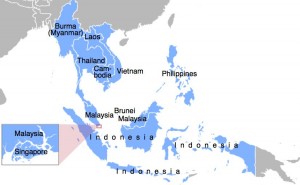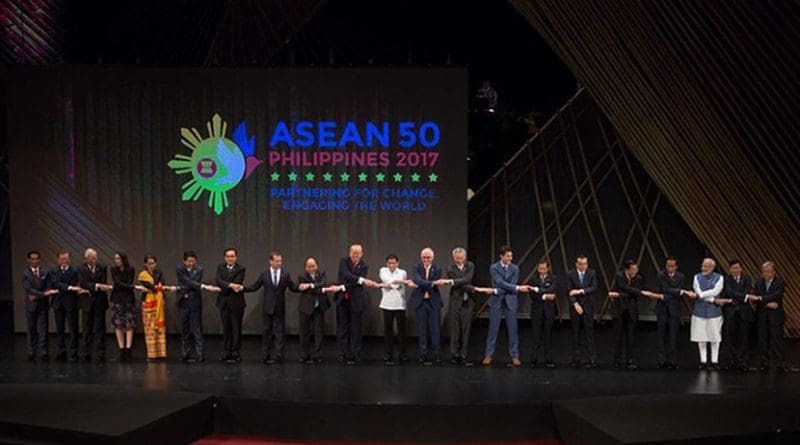The Subtlety Of ASEAN Consensus – Analysis
By RSIS
ASEAN’s 50th anniversary has been marked by claims that its consensus decision making approach is no longer fit for purpose. ASEAN needs to move beyond the straightjacket of trying to achieve unanimity among ten divergent members. This is a misreading of consensus.
By Alan Collins*
The introspection that greeted ASEAN at its 50th anniversary suggests that not all is well. True, some have been moved to call it a “miracle”, a “world star” and one deserving a Noble Peace Prize. But many others prefer to prefix ASEAN with adjectives such as adrift, confused, divided and weak.
ASEAN’s initial silence during this year’s Rohingya crisis, and the Chairman’s Statement in September that deliberately did not mention the Rohingya community by name and placed equal culpability for the crisis at the door of the Arakan Rohingya Salvation Army, appeared to confirm the criticism that ASEAN has a “culture of inaction” that prioritises procrastination.

Malaysia’s subsequent disassociation from the Chairman’s Statement as it was a misrepresentation of the situation, gave further muster to the view of ASEAN as divided and ineffectual. It certainly suggests that ASEAN is having great difficulty gaining consensus amongst a membership that has since left the familiarity created by its founding members.
Consensus, Not Unanimity
Malaysia’s public disavowing of the “Rohingya statement”, and prior to that ASEAN’s 2012 failure to issue a joint communique at the end of the Foreign Ministers Meeting in Cambodia, are headline-grabbing events that suggest consensus is indeed problematic. While this is so, the difficulty in gaining unanimity is also revealed in the increasing use in ASEAN communiques of the caveat “some ministers”, showing that a common sentiment was not accomplished.
This is seen as a failure to achieve consensus via consultation and negotiation. Is consensus no longer fit for purpose when ASEAN has become 10 and significant differences exist amongst the membership? No.
Consensus is the ASEAN solution precisely because it has not meant unanimity and it does not bestow on members a veto. If it has become interpreted in this manner then this is a political move that ASEAN members need to resist. Consensus has always meant that state elite could engage in a discussion in the knowledge that if there existed a point of disagreement, then the issue would be shelved until a time when the disagreement ceased to exist.
In essence, it ensured that no decision could be taken against outright opposition and so it enabled the elite to be at ease with one another; this no doubt helped develop the familiarity amongst the elite that captures the essence of the ASEAN Way.
Very importantly it ensured a sense of equality among the members; there is no ASEAN Security Council. Consensus was thus about being comfortable, to a greater or lesser degree, with the subjects being discussed and decisions reached. This understanding of consensus was captured in the formula, ASEAN minus X (A-X).
That is, ASEAN can proceed with a decision where some ASEAN members are more comfortable with the decision than others, so long as those others are not opposed. It did not therefore equate consensus with unanimity. It did not require all members to agree to participate and it did not give one member a veto.
Subtlety of ASEAN Diplomacy
This latter point is important to appreciate; how can equality exist if one member can prevent others from acting? If a member was opposed to an ASEAN decision, but it was in a minority of one, then consensus would publicly be said to have been achieved.
Through a process of consultation, the anomalous one would be reassured that its concerns would be respected and in return it would not prevent the others from proceeding. Being opposed did not mean becoming estranged and consensus via consultation ensured ASEAN was united in how it managed the wishes of all members.
In circumstances where those for and against are more even, then it is not unusual for the publication of a statement to accompany a declaration. While the declaration is likely to contain passages that quite often appear contradictory and reveal different positions within the membership, the statement is used to clarify a particular interpretation.
For example, when the ASEAN Human Rights Declaration (AHRD) was adopted in 2012 it was accompanied by the Phnom Penh Statement, which sought to counter the expected accusation that the AHRD fell short of international human rights standards. In those circumstances where more than one was opposed and no amount of consultation would resolve concerns then consensus equated to adjournment.
Consensus as ASEAN’s Glue
Consensus is thus the glue that holds ASEAN together. It is what marks out the ASEAN Way as being different from the adversarial posturing, majority voting and legalistic governance structures that can be found in the West. It is what enabled states that, for the most part, freed themselves from a controlling colonial power to create an institution that does not replace that colonial power with a supranational organisation that could also impinge on their independence.
It is a process that encourages independent sovereign states to work cooperatively together in a familiar, non-threatening, environment. It is this familiarity that underpins the sense of friendship that ASEAN promotes and symbolises; the latter most visible in the routine arms-crossed handshake that is performed at public ASEAN meetings.
The solution to ASEAN’s challenges as it continues on its community-building path is not to jettison consensus, but rather to ensure that it is not narrowly framed as unanimity. Equally, the A-X formula should not be consigned to just its economic pillar but instead applied to all ASEAN activity as it was originally intended.
A good start is to boldly put consensus in the name of an ASEAN commitment; something like an “ASEAN Consensus on the Protection and Promotion of the Rights of Migrant Workers”.
*Alan Collins is Professor of International Relations at Swansea University, United Kingdom and was recently a Visiting Professor with the Centre for Multilateralism Studies at the S. Rajaratnam School of International Studies (RSIS), Nanyang Technological University, Singapore.

